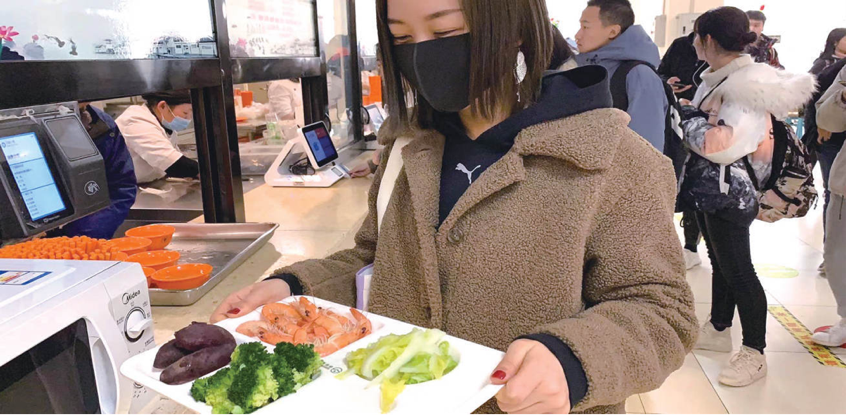Recently, with increasing people focusing on nutritious and healthy food, major restaurants and university canteens respond actively. Ordering customized meals, half portion meals or weighing food are effective ways to control dietary intake, thus ensuring healthy eating habits.

A student at Tianjin University picking up her “personalized fitness meal”, consisting of steamed purple sweet potato, boiled shrimp and broccoli.
“Fitness meals offered in our canteen are tasty, nutritious and affordable, so food delivery won’t be my choice anymore.” A sophomore at Tianjin University said with excitement that newly-set “customized fitness meal” windows in canteen solve the difficulty of choosing lunch.
To captivate students, capture their tastes first! Songyi, a deputy director of Peiyang canteen managing office at Tianjin University, said that they have solicited students’ opinions broadly before the roll-out of tailed meals. “A call for fitness meal recipe” was issued via Wechat official account followed by over 100 messages. In line with the standards of the Chinese Dietary Guideline (2016), three types of fitness meals came out, averaging 14 yuan per portion.
According to Song, weight control in fitness meals is much concerned, which helps relieve food waste. The way of “cooking in small quantities many times” could not only guarantee food quality, but save ingredients. In addition, the one-month “Empty Your Plate” campaign has seen a remarkable effect, with a 40% reduction of leftovers. Canteens in Tianjin University also set “zero iodized salt ”, “less salt and oil” and “patients’ meals” windows for students in need. Furthermore, a “tailored meal” window will be in place where students can order food in advance, making it more convenient for them.
Since China advocates a healthy lifestyle feathering “Reduction in salt, oil and sugar, Health for oral cavity, weight and bone”, a growing body of restaurants have turned to cooking tools that could limit ingredients. In this case, cooks can know well and control condiment use, therefore decreasing salt, oil and sugar in meals.
Qian Xiaoguo, a post-90s girl, has developed a habit of weighing each meal with a food-use scale and then calculating calories using a mobile application. It has become her routine to record and post these figures on social media. As obesity becomes the culprit of various chronic diseases, Qian is among the younger generation, girls in particular, who are concerned with dietary health and calorie control. That said, “Light Meal” is gaining popularity among youngsters, with balanced and moderate nutrition at its core. Increasingly, many young people are committed to a nutritious and healthy diet taking advantage of social media posts and food scales.
The release of Guideline on Catering Food Nutrition Label has promoted the development of nutrition and health industries. Professional advice has been given on balanced diet and nutritious supplement: Chinese Balance Dietary Pagoda could serve as a reference for choosing food, vegetables, fruits and quality protein such as milk. Thanks to the Guideline, the public could adjust their diet in a scientific and reasonable manner and then achieve well-balanced nutrition, with a better understanding of nutrients and corresponding proportion in their diet.
By: Chen Xu
Editor: Qin Mian